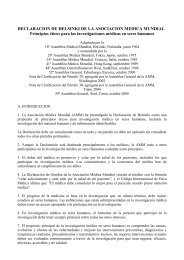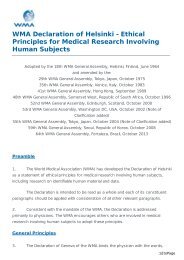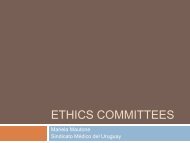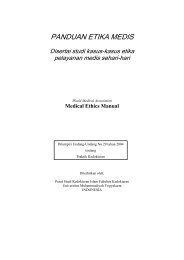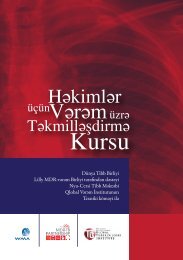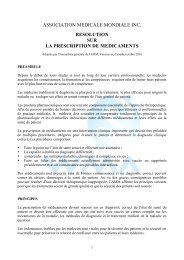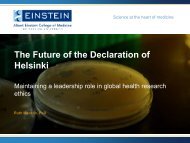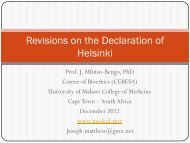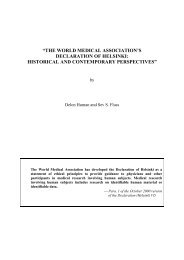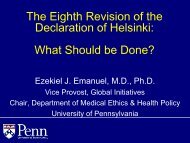WMJ 03 2010 - World Medical Association
WMJ 03 2010 - World Medical Association
WMJ 03 2010 - World Medical Association
- No tags were found...
You also want an ePaper? Increase the reach of your titles
YUMPU automatically turns print PDFs into web optimized ePapers that Google loves.
<strong>Medical</strong> Ethics, Humam Rights, Socio-medical affairs and Environmental Policy<br />
with testicular dysgenesis syndrome (TDS)<br />
[3, 4]. TDS is a grouping which comprises<br />
male genital defects at birth (cryptorchidism,<br />
hypospadias), impaired semen quality,<br />
and a type of testicular cancer (testicular<br />
germ cell tumours). Like breast cancer,<br />
TDS has been linked with fetal exposure to<br />
EDCs. Some leading European toxicologists<br />
are convinced that breast cancer rates<br />
will not be brought down until the issue<br />
of everyday exposure to harmful synthetic<br />
chemicals is addressed.<br />
Examples of endocrine disrupting chemicals<br />
mentioned in the reviews include: Bisphenol<br />
A – used in plastics and resins in<br />
baby bottles and can linings that may leach<br />
into drinks and foods; insecticides and pesticides,<br />
such as DDT and methoxychlor,<br />
which have been banned in Europe since<br />
1978 and 20<strong>03</strong> respectively, but are still<br />
found in people’s bodies; UV filters, such<br />
as benzophenone and 4-MBC, which may<br />
be used in sun screens, are another example<br />
[5].<br />
Because of concerns, France and Sweden<br />
are currently considering banning Bisphenol<br />
A for use in baby bottles as evidence<br />
increases on the need to protect biologically<br />
vulnerable groups such as babies and<br />
toddlers.<br />
Although the EU has not yet banned<br />
Bisphenol A and many other important<br />
EDCs, some European policy is already<br />
beginning the process of protecting human<br />
health through stricter regulation of uses of<br />
harmful chemicals. In 2007, a new law on<br />
chemicals called REACH (Registration,<br />
Evaluation, Authorisation and restriction<br />
of chemical substances) was agreed to ensure<br />
that all chemicals on the EU market be<br />
registered. Those considered to be “of very<br />
high concern” to human health are gradually<br />
being put through a market authorisation<br />
process.<br />
Two years later, the so-called “pesticides<br />
policy package” was agreed. One of its objectives<br />
was to reduce the impact of pesticides<br />
and harmful effects on human health<br />
and the environment. It will remove the<br />
sale and use of pesticides linked with cancer,<br />
DNA mutation, reproductive toxicity,<br />
and hormonal disruption. It also recommends<br />
that pesticide use in parks, schools<br />
and gardens around hospitals is minimised<br />
or avoided. For the implementation of this<br />
package the national level is crucial as EU<br />
Member States have to set up their own<br />
National Action Plans by 2012.<br />
HEAL is currently involved in looking at<br />
how the review of the EU’s biocide law can<br />
lead to better health protection. Biocides are<br />
defined as “chemical substances capable of<br />
killing living organisms, usually in a selective<br />
way”. They include rodenticides, wood<br />
preservatives, insecticides and anti-microbial,<br />
such as disinfectants. A particular concern<br />
is that the growing use of biocides is<br />
contributing to antibiotic resistance.<br />
Recently the European Parliament passed<br />
a resolution which strongly underlines the<br />
importance of dealing with environmental<br />
factors when working to prevent cancer.<br />
The report responds to the EU “Communication”<br />
on Action against Cancer,<br />
which already acknowledged that cancer<br />
prevention should address environmental<br />
and occupational causes on an equal footing<br />
with lifestyle considerations, such as<br />
smoking, alcohol consumption and lack of<br />
exercise.<br />
A second example: chronic respiratory illnesses<br />
Environmental policy can also play an important<br />
role in reducing chronic health<br />
problems associated with lung disease.<br />
Lung disease is rising worldwide and its total<br />
financial burden in Europe amounts to<br />
nearly €102 billion. Chronic Obstructive<br />
Pulmonary Disease (COPD) contributes<br />
almost one-half of this figure followed by<br />
asthma, pneumonia, lung cancer and TB.<br />
Although air quality has improved over the<br />
past 20 years, it is still responsible for some<br />
310,000 premature deaths within the European<br />
Union, according to a report by the<br />
European Commission [6].<br />
Research commissioned by the Health and<br />
Environment Alliance (HEAL) and others<br />
in 2008 showed the extent to which better<br />
air quality through strong climate change<br />
policy would benefit health as a side effect<br />
[7]. This would happen because reaching<br />
climate change targets involves moving to<br />
energy sources with lower of emissions of<br />
carbon dioxide and other air pollutants,<br />
which would result in cleaner air.<br />
The review showed that if the EU moved<br />
to a 30% target on greenhouse gas emission<br />
reductions (compared with the EU’s current<br />
target of 20% by 2020), 100,000 fewer years<br />
of life would be lost to air pollution among<br />
Europeans (over 30 years of age) every year<br />
from 2020. In monetary terms, the overall<br />
public health benefits of the 30% reductions<br />
climate policy was estimated to be up to 25<br />
billion Euros per year by 2020 [7].<br />
The <strong>World</strong> <strong>Medical</strong> <strong>Association</strong> helped to<br />
bring the message of these health co-benefits<br />
of climate change policy to the attention<br />
of policy makers and the media, both<br />
in Brussels and at the Copenhagen climate<br />
summit at the end of 2009. WMA joined<br />
101



